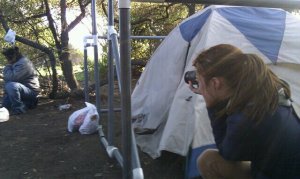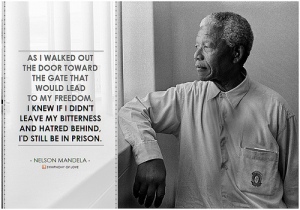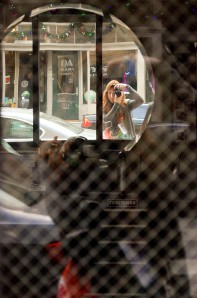As the year comes to an end, I’ve decided to spend some time looking through the Committee to Protect Journalists website for statistics on the amount of journalists that have been killed throughout the world covering conflicts. The staff at CPJ documents hundreds of attacks on the press each year and bases its advocacy on this research. They compile detailed records on journalists that have been killed, imprisoned, and exiled. For this post, I decided to gather information on the deadliest countries in 2013 for journalists and created a graph that can be seen here. We’ve lost a lot of journalists covering the conflicts in Libya, Egypt, and Syria these past few years. A very small percentage of those journalists that were killed were mentioned in the news. I recommend spending some time clicking around this site to get a better understanding of what your news costs.
Author Archives: jlwphoto20
A Pop-Up Passion
Wes Rowe, an SF State graduate and freelance photojournalist in the Bay Area can make an impressive burger. The layers of creativity seen in his photographs can also be found sandwiched between freshly baked buns every Wednesday and Sunday evening. Rowe has joined the pop-up scene in San Francisco, taking his passion for making gourmet hamburgers to local cafes and restaurants that open up their kitchens to him. Perhaps being a freelancer has made it much easier for him to pursue both passions on his own terms. It’s always nice to meet someone who really enjoys what they do for a living! Now, if you’re living in San Francisco, I urge you to watch this video on a Wednesday or Sunday because I can assure you that you’ll want one.
The Juggling Act
There should be a special award for those college students who balance a full load of classes, work a job or two, and take on an internship without losing their mind. Forgiveness of all student loans would be nice, but that doesn’t seem likely in the near future.
So why do they take on so much at a time? Is that internship really worth it to be successful after graduation…worth those few hours left of free time that could be spent actually reading the book they have to write a paper on, or getting in that power nap they’ve been looking forward to for the past two days?
Exposure decided to focus on the topic of internships this week. Deb Svoboda, a photojournalism student from San Francisco State University and Tearsa Hammock, a recent graduate from the same program, are here to tell you what their thoughts are on internships and if they think it’s a good use of your time. So if you’re on the fence about whether you should consider an internship as a photojournalism student or recent graduate, listen up.
Advice From The Field: Part 2
As a continuation from my previous post on the process I took to get advice from photojournalists in the field, this post will provide their answers to help guide you in your process. I sent out a handful of emails to photojournalists across a broad platform of news agencies and I will be sharing two email responses from David Burnett and Jim Richardson.
Burnett is a magazine photojournalist who began his career working for Time and Life magazines. Burnett was one of the photojournalists present at Trảng Bàng when Nick Ut of the AP captured his famous image of the nine-year-old Vietnamese girl Phan Thị Kim Phúc fleeing a napalm attack. In fact, he was standing right next to Ut when the shot was captured, but Burnett’s camera was busted and he missed the shot. He’s won many awards including the World Press Photo of the Year and co-founded Contact Press Images, a news photo agency in New York City where he also freelances for The New York Times.
His advice is as follows:
- The ‘business’ side of our business is crumbling, but there needn’t be despair alone. There are still things to do, places to see and photograph, and projects to make happen.
- I got my B.A. in Political Science at Colorado College, a school where no photo classes were offered. Most of the photogs I know who were/are successful are self-taught. They may have had a few classes along the way, but most did it by trial and error, driven by desire and curiosity.
- I think the things you need to know include : web usage and design; and corresponding to that, layout (magazine/book/newspaper/web), and the ability to navigate happily in Photoshop, ancillary tools, and Final Cut Pro.
- You need to know video and how to edit it, even if only to edit your stills (and audio) into something that is web useable.
- You should have some language skills and know something of the world. For instance, read newspapers either in paper or online form. Having some insight into what is happening in the world will give you a leg up over others.
- History, sociology, political science, economics, and marketing…all of those NON photo subjects are probably THE most important in my view.
- Study the great photogs of our time. Start with August Sander, Martin Chiambi, and shoot right through the 20th century. KNOW good photographs and why they are good. Cartier-Bresson (who shot with the simplest Leica, nothing ‘auto’ about it), Gene Smith, Leonard McCombe (LIFE), Grey Villet (LIFE), Bill Eppridge (LIFE), Salgado…the list goes on and on, but only good can come from your paying attention to what has been done by those who went before you. Just because you can see your work instantly on the back of a digital camera doesn’t mean you’re special.
- Take your inspiration where you can and never stop looking for good images both by others and those that happen in front of your own eyes
Richardson has been a freelance photojournalist for National Geographic magazine for almost 30 years, making him one of the top contributing photographers at the publication. He is also a contributing editor of National Geographic Traveler magazine, where he both writes and photographs. He leads photo workshops in the U.S. and abroad. In 2001, he was featured in an ABC News segment for a piece called Yellow Journalism : The Making of a National Geographic Story.
His advice is as follows:
- I am not able to describe one surefire path to a successful photojournalism career. For me, it took experimenting with a camera throughout my childhood; a series of aborted majors in college, finally ending up with the most credits in psychology.
- I landed an internship at the Topeka Capital-Journal and then worked there alongside Pulitzer-Prize winners and some of the best in the business for 15 years.
- I freelanced for Time, Life, The New York Times, and Sports Illustrated while publishing my self-assigned documentary projects in both book and magazine form before I even came to the attention of the National Geographic editors.
- If you were to examine the backgrounds of 40 photographers who shoot mostly for the National Geographic magazine, you’ll see men and women with all sorts of backgrounds and paths to their jobs. A good number have newspaper backgrounds; many of the newer generation of photographers have backgrounds in the sciences.
- I tell students that they should get an advanced degree (MS or PhD) in a science or in sociology and at the same time develop their photographic skills, using not only cameras, but also computers.
- The future of editorial photography is likely seated in people who have particular expertise in parts of the world or in a specific species of animals or insects, or in cultures.
- Editors were looking for generalist photographers 25 years ago, but that won’t do now. If National Geographic wants someone to shoot an underwater story or a tribe in South America or excavations in Egypt, editors don’t often look at me. I have been able to carve out areas of expertise…British Isles, Celtic history and influence, environmental issues like water supply and quality, agriculture, volcanoes, and Cuba, Kansas.
- I generate my own story ideas rather than wait for ideas to come from editors.
- The bottom line is this: You should seek an education through which you can develop great photographic, organizational, research and writing skills…plus have a depth of knowledge in at least one area of science or culture, preferably more.
- Study the works of photographers you admire.
- Shoot, shoot, shoot. There is no substitute for working with a camera in your hands every day. Give yourself ideas and figure out how to tell stories. Take workshops and photo classes as often as possible.
Some of the advice they both give overlaps and I would stress that those parts are very important to consider. Reaching out to these photographers taught me that they want to help all of us get to where we are going. We are the next generation of photojournalists and they want to prepare us as best as they can, so don’t be nervous to ask for help. Ask more questions, take creative risks, and develop an understanding of the world around you…through pictures, of course.
Advice From The Field : Part 1
It wasn’t too long ago that I was sitting in front of my computer feeling stuck and overwhelmed with the next step I needed to take in my desire to pursue a career in photojournalism. Simply put, I had no idea what to do. I was getting closer to graduating with my associate’s degree — too close for someone not prepared for her next step.
I had purposely avoided the counselors at my college after seeing them recommend unnecessary classes to my friends that resulted in two-year degrees taking four years to attain. My own experience of sitting down in one of their offices in hopes of getting some advice on where to apply to next started with me defining what photojournalism was and ended immediately afterward.
In that moment of uncertainty and desperation I decided to go straight to the source. A professor of mine once said that the worst thing someone could tell you is “no” and that it wouldn’t kill you.
I went home that night, sat down in front of the computer, and brought up news sites like National Geographic and The New York Times. I sifted through image after image, located ones that inspired me and then shifted my eyes toward the photo credit below the pictures. I wrote down the names of the photographers and then did a search on them in hopes of finding their contact information.
After what seemed like only an hour, I had a small list of photographers and their email addresses…even a few numbers! The thought crossed my mind that it couldn’t be that easy. Maybe they had their own employees answering their phones and emails…I mean, these photographers worked for the biggest news sources in the world. With that uncertainty still looming over my head, I wrote and asked for advice.
Two days later brought me two detailed replies. I don’t think I’ll ever forget my reaction to opening those emails. For the first time since wanting to be a photojournalist, I felt the certainty that it was going to happen. It was like hanging off the side of a cliff and having someone throw you a rope (not that I’ve ever experienced this…yet).
I will be sharing the advice I was given from these photographers with you in the coming week and urge you to follow the steps I did if you are finding yourself in a similar situation. Remember, the worst thing anyone can say is “no” and in this field you will hear that a lot, but let it motivate you to keep at it!
Improve Your Stories With 5 Shot Sequences
Don’t limit yourself to just shooting still frames as a photojournalist. It’s imperative that you learn how to use a video camera and be comfortable using it. Most jobs available for photojournalists these days require that they know how to shoot with a video camera and edit in the latest software. The 5-shot sequence will make this a much easier transition for you. It’s basically five different angles of your subject to create the entire story in only five shots. This will help you when you’re shooting stills, as well. You won’t be asked to shoot an event again if you come back with multiple shots all taken at the same distance because it’s boring and leaves out so much detail. Here’s an example of a 5-shot sequence taken in 6 seconds of a trombone player practicing her music to give you an idea of the variety of angles you can use to make it interesting.
Virginia Tieman, 22, a senior at San Francisco State University practices her trombone to prepare for a concert at the university tonight.
Photojournalism Career Ranked Lower Than Dishwasher

Shooting a freelance piece I did called Slipping Away. http://www.fogcityjournal.com/wordpress/4929/slipping-away-mentally-ill-homeless-recieve-no-care/
So you’ve decided you want to be a photojournalist. You’ve done research on the career and have come to accept the fact that you’ll never be rich. You’re prepared to spend more money on your gear than where you’ll be living and to invent your own holidays to make up for the ones you’ll be working through.
This doesn’t seem too bad though right? I mean, every career has its downfalls.
But then 2013 comes around the corner bringing with it CareerCast’s list of the 200 worst jobs in the world and your curiosity gets the best of you.
You start at number one, watching the jobs get worse based on hiring rate, stress, and work environment, as you scroll down the page. Then you see it. Sandwiched between Dishwasher and Corrections Officer sits Photojournalist at number 188. For a brief moment you consider jumping to newspaper reporting and reassure yourself that you can write well, but then realize that a newspaper reporter ranks in at 200–the worst job in the world for 2013.
This becomes the moment when you realize whether or not photojournalism is a passion of yours. It’s this passion that will carry you through the late nights, low-income, constant stress, and life-threatening situations with a smile on your face and a certainty in your heart.
Pulitzer-Prize winner Cheryl Diaz Meyer once said, “In my heart, I truly believe that photojournalism is a calling, and that being allowed to witness and document the world’s news and sometimes tragedies, is an honor and a weighty responsibility.”
In those moments you’re reminded that being a Dishwasher is considered a step up from a Photojournalist, also remember that they’re stuck inside all day and don’t get to travel the world.
So hold onto that passion, pick up your camera, and go record history.
Plummeting into Danger
If you type “movies about photojournalism” into Google and scroll down, you’ll see link after link of “top 10” “top 25” “top 30” movies that every photojournalist should see. I’m going to focus on one film that should be in each one of those categories.
The Bang Bang Club, which premiered days after the deaths of award-winning photojournalists Tim Hetherington and Chris Hondros, presents the dangers and anguish that photojournalists work through to enlighten the world. It portrays the real-life stories of four South African combat photographers during the 1990s as they captured the brutality generated by free elections during post-Apartheid.
As photojournalists, we will always be asked why we do what we do when the risk of death is so high. We will be asked tough questions like when to draw the line between snapping the shutter and helping those around us.
There are many famous photographs of war that have been burned into our memory. The starving Sudanese child sitting on the ground while a vulture waits behind her during the 1993 famine not only won a Pulitzer prize, it brought the ethical nature of photographer Kevin Carter (one of the men portrayed in the movie) into question. He was widely criticized for not helping the child. He became depressed and later committed suicide. The Bang Bang Club focuses on these questions of morality and the ethical line we balance on. It’s because of this that I recommend it to those of you considering this career.
Society needs to be reminded and photographers reassured that without our photographs, we lose our visual history. And because of this, there will always be someone jumping at the opportunity to accept these terrible risks with a sense of purpose.
A Wise Man
“For me, the strength of photography lies in its ability to evoke humanity. If war is an attempt to negate humanity, then photography can be perceived as the opposite of war.”
– James Nachtwey




